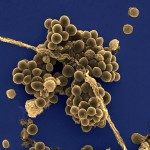Link to Pubmed [PMID] – 9141688
Microbiology (Reading, Engl.) 1997 Apr;143 ( Pt 4):1253-61
An excision reporter plasmid was constructed to characterize the intracellular mobility of Tn916 in various Gram-positive bacteria. The reporter component of this plasmid is a chloramphenicol-resistance gene which has been insertionally inactivated with the integrative vector pAT112 containing the attachment site of Tn916. Tn916-mediated excision of pAT112, to produce clones resistant to chloramphenicol, was detected in Enterococcus faecalis BM4110, Listeria monocytogenes L028-Str and Streptococcus gordonii BM120, but not in Lactococcus lactis MG1363-RF or in Streptococcus pneumoniae BM124, and always depended upon the ability of the bacterial host to generate circular forms of the transposon. The results suggest that (i) the excision event, although required, is not sufficient for conjugal transfer to occur and (ii) there is no linear relationship between the donor potential of E. faecalis strains and either the excision frequency of pAT112 or the copy number of Tn916 circular intermediates per cell in these hosts. Excision of pAT112 occurred mainly during the late exponential phase of growth of E. faecalis and L. monocytogenes and this recombination event was not stimulated by heat shock, salt and alcohol stresses or by the presence of tetracycline in the medium.

